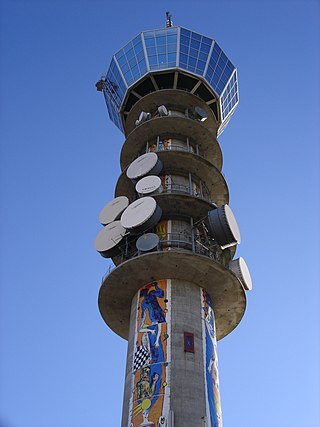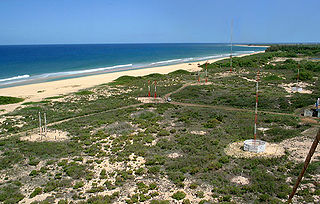Related Research Articles

Shortwave radio is radio transmission using shortwave (SW) radio frequencies. There is no official definition of the band, but the range always includes all of the high frequency band (HF), which extends from 3 to 30 MHz ; above the medium frequency band (MF), to the bottom of the VHF band.
International broadcasting, in a limited extent, began during World War I, when German and British stations broadcast press communiqués using Morse code. With the severing of Germany's undersea cables, the wireless telegraph station in Nauen was the country's sole means of long-distance communication.

Medium wave is the part of the medium frequency radio band used mainly for amplitude modulation radio broadcasting. The spectrum provides about 120 channels with more limited sound quality than frequency modulation stations on the FM broadcast band. During the daytime, reception is usually limited to more local stations, though this is dependent on the signal conditions and quality of radio receiver used. Improved signal propagation at night allows the reception of much longer distance signals. This can cause increased interference because on most channels multiple transmitters operate simultaneously worldwide. In addition, amplitude modulation is often more prone to interference by various electronic devices, especially power supplies and computers. Strong transmitters cover larger areas than on the FM broadcast band but require more energy and longer antennas. Digital modes are possible but have not reached momentum yet.

In radio, longwave, long wave or long-wave, and commonly abbreviated LW, refers to parts of the radio spectrum with wavelengths longer than what was originally called the medium-wave broadcasting band. The term is historic, dating from the early 20th century, when the radio spectrum was considered to consist of longwave (LW), medium-wave (MW), and short-wave (SW) radio bands. Most modern radio systems and devices use wavelengths which would then have been considered 'ultra-short'.

Radio broadcasting is the broadcasting of audio (sound), sometimes with related metadata, by radio waves to radio receivers belonging to a public audience. In terrestrial radio broadcasting the radio waves are broadcast by a land-based radio station, while in satellite radio the radio waves are broadcast by a satellite in Earth orbit. To receive the content the listener must have a broadcast radio receiver (radio). Stations are often affiliated with a radio network that provides content in a common radio format, either in broadcast syndication or simulcast, or both. Radio stations broadcast with several different types of modulation: AM radio stations transmit in AM, FM radio stations transmit in FM, which are older analog audio standards, while newer digital radio stations transmit in several digital audio standards: DAB, HD radio, DRM. Television broadcasting is a separate service that also uses radio frequencies to broadcast television (video) signals.

The R-S-T system is used by amateur radio operators, shortwave listeners, and other radio hobbyists to exchange information about the quality of a radio signal being received. The code is a three digit number, with one digit each for conveying an assessment of the signal's readability, strength, and tone. The code was developed in 1934 by Amateur radio operator Arthur W. Braaten, W2BSR, and was similar to that codified in the ITU Radio Regulations, Cairo, 1938.
TV DX and FM DX is the active search for distant radio or television stations received during unusual atmospheric conditions. The term DX is an old telegraphic term meaning "long distance."
CHU is the call sign of a shortwave time signal radio station operated by the Institute for National Measurement Standards of the National Research Council. CHU's signal is used for continuous dissemination of official Canadian government time signals, derived from atomic clocks.

WWVH is the callsign of the U.S. National Institute of Standards and Technology's shortwave radio time signal station located at the Barking Sands Missile Range, in Kekaha, on the island of Kauai in the state of Hawaii.

Radio Havana Cuba is the official government-run international broadcasting station of Cuba. It can be heard in many parts of the world including the United States on shortwave frequencies. Radio Havana, along with Radio Rebelde, Cubavision Television and other Cuban radio and television broadcasts to North, Central and South America via free-to-air programming from the Hispasat 30W-6 satellite over the Atlantic Ocean and via Internet streaming.
A signal strength and readability report is a standardized format for reporting the strength of the radio signal and the readability (quality) of the radiotelephone (voice) or radiotelegraph signal transmitted by another station as received at the reporting station's location and by their radio station equipment. These report formats are usually designed for only one communications mode or the other, although a few are used for both telegraph and voice communications. All but one of these signal report formats involve the transmission of numbers.

Shortwave listening, or SWLing, is the hobby of listening to shortwave radio broadcasts located on frequencies between 1700 kHz and 30 MHz. Listeners range from casual users seeking international news and entertainment programming, to hobbyists immersed in the technical aspects of radio reception and collecting official confirmations that document their reception of distant broadcasts (DXing). In some developing countries, shortwave listening enables remote communities to obtain regional programming traditionally provided by local medium wave AM broadcasters. In 2002, the number of households that were capable of shortwave listening was estimated to be in the hundreds of millions.
Radio jamming is the deliberate jamming, blocking or interference with wireless communications. In some cases, jammers work by the transmission of radio signals that disrupt communications by decreasing the signal-to-noise ratio.
HCJB, "The Voice of the Andes", was the first radio station with daily programming in Ecuador and the first Christian missionary radio station in the world. The station was founded in 1931 by Clarence W. Jones, Reuben Larson, and D. Stuart Clark. HCJB now focuses on Ecuador with unified programming on FM at 89.3 MHz in Pichincha, at 92.5 MHz in Manabí, at 96.1 MHz in Tungurahua and Cotopaxi, at 98.3 MHz in Esmeraldas and with separate programming on AM at 690 kHz. Broadcasts in Spanish and indigenous languages on 6.05 MHz (1 kW), continue on an intermittent basis with a new solid state transmitter which in 2017 replaced an older (5 kW) transmitter. These broadcasts were not listed on the HCJB English website as of February 2016.
DXing, taken from DX, the telegraphic shorthand for "distance" or "distant", is the hobby of receiving and identifying distant radio or television signals, or making two-way radio contact with distant stations in amateur radio, citizens band radio or other two-way radio communications. Many DXers also attempt to obtain written verifications of reception or contact, sometimes referred to as "QSLs" or "veries".
SINPO, an acronym for Signal, Interference, Noise, Propagation, and Overall, is a Signal Reporting Code used to describe the quality of broadcast and radiotelegraph transmissions. SINPFEMO, an acronym for Signal, Interference, Noise, Propagation, frequency of Fading, dEpth, Modulation, and Overall is used to describe the quality of radiotelephony transmissions. SINPFEMO code consists of the SINPO code plus the addition of three letters to describe additional features of radiotelephony transmissions. These codes are defined by Recommendation ITU-R Sm.1135, SINPO and SINPFEMO codes.
MW DX, short for mediumwave DXing, is the hobby of receiving distant mediumwave radio stations. MW DX is similar to TV and FM DX in that broadcast band (BCB) stations are the reception targets. However, the nature of the lower frequencies used by mediumwave radio stations is very much different from that of the VHF and UHF bands used by FM and TV broadcast stations, and therefore involves different receiving equipment, signal propagation, and reception techniques.

A QSL card is a written confirmation of either a two-way radiocommunication between two amateur radio or citizens band stations; a one-way reception of a signal from an AM radio, FM radio, television or shortwave broadcasting station; or the reception of a two-way radiocommunication by a third party listener. A typical QSL card is the same size and made from the same material as a typical postcard, and most are sent through the mail as such.

Radio Ukraine International, abbreviated RUI, is the official international broadcasting station of Ukraine, with foreign language news and programming being produced by Ukrainian Radio's main editorial department for broadcasting in EBU languages. RUI broadcasts in Belarusian, Bulgarian, English, German, Hungarian, Polish, Romanian, Russian and Slovak. The Ukrainian language programming aired on RUI is produced by the domestic First Channel.
A plain-language radio check is the means of requesting and giving a signal strength and readability report for radiotelephony (voice) communications, and is the direct equivalent to the QSA and QRK code used to give the same report in radiotelegraph communications. SINPEMFO code is the voice signal reporting format developed by the ITU in 1959, but sees little use outside of shortwave listeners.
References
- ↑ Quick Guide to Reception Reports Archived May 31, 2008, at the Wayback Machine
- ↑ Writing Useful Reception Reports http://www.dxinginfo.com/dx-reception-reports.html Archived May 31, 2008, at the Wayback Machine